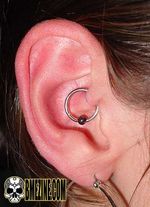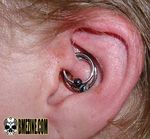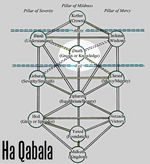Daith: Difference between revisions
(Created page with "<html><div class="mw-content-ltr" dir="ltr" id="mw-content-text" lang="en"><p>A <b>Daith</b> piercing is a ear piercing that passes through the ear's innermost <a href="/index.php?title=Cartilage" title="Cartilage">cartilage</a> fold. In most areas this piercing is pronounced <i>"day-th"</i> although the proper pronunciation is <i>"doth"</i> (rhymes with <i>"moth"</i>). </p><p>A client of <a href="/index.php?title=Erik_Dakota" title="Erik Dakota">Erik Dakota</a>, that is...") |
(Page conversion via llm-mediawiki-rev -jwm) |
||
| Line 1: | Line 1: | ||
'''A '''Daith''' piercing''' is a ear piercing that passes through the ear's innermost [[Cartilage|cartilage]] fold. In most areas this piercing is pronounced ''"day-th"'' although the proper pronunciation is ''"doth"'' (rhymes with ''"moth"''). | |||
A client of [[Erik Dakota]], that is said to have been studying Hebrew in college, first named this piercing ("daath" meaning "knowledge"). Her reasoning was that the piercer must have been very "smart" to figure out how to do the piercing. This piercing was first brought into the public eye in [[Fakir Musafar]]'s [[Body Play Magazine]], in the same issue that also showcased the [[Industrial Piercing]], the [[Apadydoe]], and a large [[Dermal punch]] in the [[Outer conch]]. | |||
The actual root word of the piercing is the "da'at", a part of the Kabbalistic tree of life traditionally representing the union of wisdom and understanding. In more modern times daath has come to represent the void or the abyss ("the sacred nothing"), or the hole left behind when Malkuth fell out of the Garden of Eden. | |||
{| | |||
|center|[[File:Daith-1.jpg|150px|thumb|right|Daith]] | |||
|center|[[File:Daith-2.jpg|150px|thumb|right|Daith]] | |||
|center|[[File:Daith-3.jpg|150px|thumb|right|Daith]] | |||
|} | |||
[[Fakir Musafar]] wrote in with some corrections to this entry that should be noted: | |||
:''The '''Daith''' piercing was co-created in [[1992]] by [[Erik Dakota]] and a Jewish woman piercing client with a metaphysical bent. Erik (my second [[Piercing school]] student) was piercing in Santa Cruz then and we were collaborating on our new jewelry company, [[Dakota Steel]], Inc. The woman instinctively understood what the [[Hindu]]s had been teaching about body piercings for about 3,000 years: that rings left in an orifice of the body act as a ''"Guardian of the Gate"''. They can be magically charged at the moment of the pierce to act as a "filter" to what goes into and out from that orifice. | |||
In the case of the ear, an appropriately placed and charged ring could filter out all that is nonsense or bullshit and let pass that which is intelligent. Erik and the unnamed woman were guided to create a piercing to do just that and the woman gave it the Hebrew name for intelligence: Daith. A true Daith must be done in such a way that the bottom part of the ring appears to come directly out of the ear canal. If one can see both the entrance and exit hole of the ring, it is not a true Daith. The technique for this piercing is quite advanced, requires a specifically curved needle and was devised by Erik Dakota. We teach this technique at our Advanced [[Fakir Piercing Intensive]]'' | |||
:''Reference: BODY PLAY #4, [[1992]], "The Unique Piercings of Erik Dakota"'' | |||
So by the strictest of definitions, one could argue that most piercings people call "daith" (including the ones in this entry), strictly speaking, are not ''quite'' actual daith piercings as they were originally invented and defined! | |||
==Related Risks== | |||
* [[Bell's Palsy]] | |||
* [[Ear Collapse]] | |||
* [[Loss of Hearing]] | |||
* [[Rejection]] | |||
Latest revision as of 02:19, 17 September 2023
A Daith piercing is a ear piercing that passes through the ear's innermost cartilage fold. In most areas this piercing is pronounced "day-th" although the proper pronunciation is "doth" (rhymes with "moth").
A client of Erik Dakota, that is said to have been studying Hebrew in college, first named this piercing ("daath" meaning "knowledge"). Her reasoning was that the piercer must have been very "smart" to figure out how to do the piercing. This piercing was first brought into the public eye in Fakir Musafar's Body Play Magazine, in the same issue that also showcased the Industrial Piercing, the Apadydoe, and a large Dermal punch in the Outer conch.
The actual root word of the piercing is the "da'at", a part of the Kabbalistic tree of life traditionally representing the union of wisdom and understanding. In more modern times daath has come to represent the void or the abyss ("the sacred nothing"), or the hole left behind when Malkuth fell out of the Garden of Eden.
Fakir Musafar wrote in with some corrections to this entry that should be noted:
- The Daith piercing was co-created in 1992 by Erik Dakota and a Jewish woman piercing client with a metaphysical bent. Erik (my second Piercing school student) was piercing in Santa Cruz then and we were collaborating on our new jewelry company, Dakota Steel, Inc. The woman instinctively understood what the Hindus had been teaching about body piercings for about 3,000 years: that rings left in an orifice of the body act as a "Guardian of the Gate". They can be magically charged at the moment of the pierce to act as a "filter" to what goes into and out from that orifice.
In the case of the ear, an appropriately placed and charged ring could filter out all that is nonsense or bullshit and let pass that which is intelligent. Erik and the unnamed woman were guided to create a piercing to do just that and the woman gave it the Hebrew name for intelligence: Daith. A true Daith must be done in such a way that the bottom part of the ring appears to come directly out of the ear canal. If one can see both the entrance and exit hole of the ring, it is not a true Daith. The technique for this piercing is quite advanced, requires a specifically curved needle and was devised by Erik Dakota. We teach this technique at our Advanced Fakir Piercing Intensive
- Reference: BODY PLAY #4, 1992, "The Unique Piercings of Erik Dakota"
So by the strictest of definitions, one could argue that most piercings people call "daith" (including the ones in this entry), strictly speaking, are not quite actual daith piercings as they were originally invented and defined!


